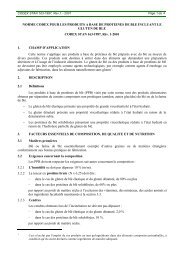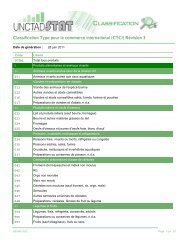issues and constraints related to the development of cashew nuts ...
issues and constraints related to the development of cashew nuts ...
issues and constraints related to the development of cashew nuts ...
You also want an ePaper? Increase the reach of your titles
YUMPU automatically turns print PDFs into web optimized ePapers that Google loves.
6Damage symp<strong>to</strong>ms:Damage <strong>to</strong> trees is quite characteristic, branches are completely girdled, with a V-section cut by<strong>the</strong> adult beetles. Only a small segment <strong>of</strong> <strong>the</strong> branch remains, which is <strong>to</strong>o weak <strong>to</strong> hold <strong>the</strong> fullweight <strong>and</strong> hence <strong>the</strong> branch eventually breaks <strong>of</strong>f. The purpose <strong>of</strong> <strong>the</strong> girdling is <strong>to</strong> providesuitable breeding material for <strong>the</strong> larvae, in <strong>the</strong> form <strong>of</strong> dead wood. Eggs are laid on <strong>the</strong> cutbranch <strong>and</strong>, on hatching , <strong>the</strong> larvae burrow in<strong>to</strong> <strong>the</strong> wood. The adult is a typical “longicorn”beetle with attractive colour; it can reach a length <strong>of</strong> about 55mm <strong>and</strong> its antennae a fur<strong>the</strong>r70mm. The adult is generally black, with 3 bright orange coloured b<strong>and</strong>s on <strong>the</strong> wing cases.Lefebvre et al (1973) recommend <strong>the</strong> frequent spraying with insecticide <strong>to</strong> control this pest, butthis is probably nei<strong>the</strong>r economic, nor desirable nowadays. The diligent, immediate removal <strong>and</strong>careful burning <strong>of</strong> girdled branches should help in <strong>the</strong> control <strong>of</strong> this pest.O<strong>the</strong>r insect pestsO<strong>the</strong>r insect pests <strong>of</strong> minor importance have been seen, or mentioned by farmers, at <strong>the</strong> time <strong>of</strong><strong>the</strong> survey. It should be noted that populations <strong>of</strong> many, even minor pest species, can fluctuatedramatically in response <strong>to</strong> changing environmental conditions <strong>and</strong>, in some years, can causeserious economic damage.Aphids (Hemiptera; Aphididae)Aphids were present at a few site,s but were not economically important. There are many specieswithin <strong>the</strong> Aphididae family <strong>and</strong> many are polyphagous, feeding on a range <strong>of</strong> crops <strong>and</strong> o<strong>the</strong>rnon-crop plant species. When attacking <strong>cashew</strong>, <strong>the</strong>y live on young shoots <strong>and</strong> foliage. Often<strong>the</strong> severity <strong>of</strong> aphid attack varies from year <strong>to</strong> year <strong>and</strong> place <strong>to</strong> place; with a heavy attack,shoots <strong>and</strong> panicles can be killed. Like thrips, aphids are usually a dry season pest, disappearingas soon as <strong>the</strong> heavy rains start. Aphids can be controlled naturally by a number <strong>of</strong> o<strong>the</strong>r insectpreda<strong>to</strong>rs <strong>and</strong> parasites.LepidopteraLeaf miner <strong>and</strong> leaf roller damage were frequently seen, but were always <strong>of</strong> minor importance.TermitesTermites were seen attacking one or two young trees during <strong>the</strong> course <strong>of</strong> <strong>the</strong> survey, <strong>and</strong> <strong>the</strong>termite Cop<strong>to</strong>fermes intermedius (Isoptera, Rhinotermidae) was listed as a pest by <strong>the</strong> PlantProtection Department in Guinea Bissau.Mealybugs (Hemiptera, family Pseudococcidae)Mealybug was seen only on two occasions. It was present on many panicles at one farm in Lafia,Nigeria, <strong>and</strong> on an isolated tree at <strong>the</strong> <strong>cashew</strong> processing fac<strong>to</strong>ry at Korhogo, Cote d’Ivoire. It isworth mentioning that Pseudococcus longispinus is a serious pest in parts <strong>of</strong> Tanzania <strong>and</strong>Mozambique <strong>and</strong> it is very difficult <strong>to</strong> control.From <strong>the</strong> literaturePachnoda sp (Coleoptera, Scarabaeidae), noted in questionnaires from both Guinea <strong>and</strong> Nigeriaas being a significant pest, was not seen during <strong>the</strong> field surveys.



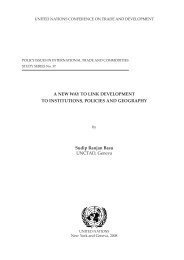
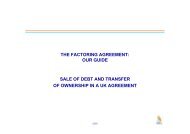


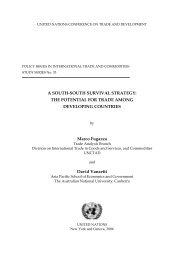
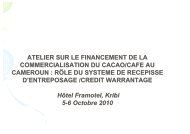
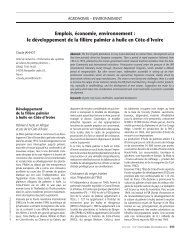
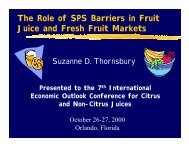

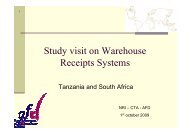
![Warehouse Receipt Systems: Legal Issues [PDF]](https://img.yumpu.com/43979338/1/190x134/warehouse-receipt-systems-legal-issues-pdf.jpg?quality=85)
